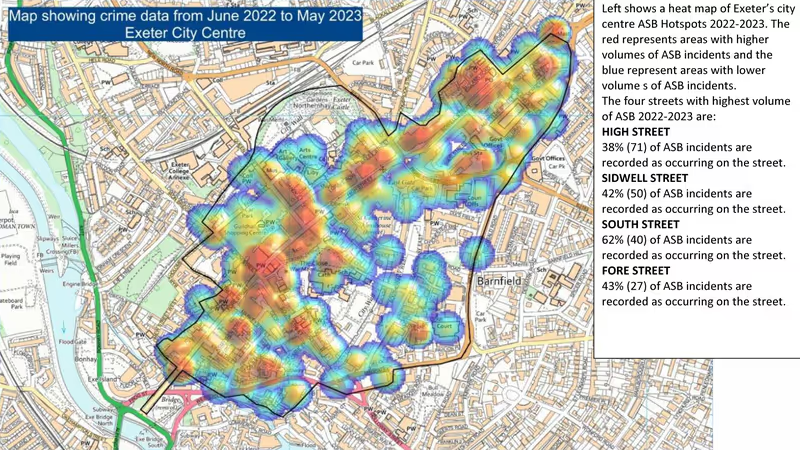A University of Exeter Centre for Energy and the Environment study of citywide territorial greenhouse gas emissions has found that Exeter will not only fail to reach its locally-set goal of reaching net zero by 2030, it is also set to overshoot the national 2050 net zero target.
The study found that Exeter’s territorial emissions fell from 511,000 tonnes CO2e to 466,000 tCO2e over the three years to 2022, after methodological revisions added 35,000 tCO2e to the university’s previous 2019 assessment.
However its authors said that most of the decline was a result of wider power sector decarbonisation through national renewable electricity generation.
They added that while emissions from Exeter buildings fell 15,000 tCO2e in the year to 2022 this was mostly due to warmer temperatures and higher energy prices that had resulted in lower fuel demand.
Similarly, they said Exeter transport emissions fell 3,000 tCO2e over the same period, not because of local action but because motor vehicles are slowly becoming more efficient and consuming less fuel.
 Exeter territorial emissions sources. Image: University of Exeter.
Exeter territorial emissions sources. Image: University of Exeter.
The study’s authors said the lack of progress in buildings and transport is “particularly concerning as these sectors are major sources of greenhouse gas emissions, and reductions fall well short of the level of change required to meet zero emissions”.
They added: “Data shows that radical reductions in emissions across all sectors were not delivered in 2021, nor in 2022, and it is unlikely that they were delivered in 2023.”
As a result, they said, reaching net zero by 2030 would require territorial emissions reductions of 74,000 tCO2e in each of the six years from 2024 at “7.4 times the reduction rate of the current trend”.
On Exeter’s current trajectory its annual territorial emissions would still be 357,000 tCO2e by 2030.
 Exeter territorial emissions vs linear trajectory to zero by 2030. Image: University of Exeter.
Exeter territorial emissions vs linear trajectory to zero by 2030. Image: University of Exeter.
The study also found that Exeter’s cumulative territorial greenhouse gas emissions from 2021 to 2030 are expected to reach 4,200,000 tCO2e on the city’s current trajectory.
Its authors said this is “almost double the projection of 2,200,000 tCO2e” that the city would have reached “had a linear decline been achieved as set out just two years ago”.
They added that the emissions reduction rate required for Exeter to reach territorial net zero by 2030 has “increased by almost half” since 2021, and that the city’s cumulative emissions have “increased by over a third” as a result.
 Exeter cumulative territorial emissions alternative trajectories. Image: University of Exeter.
Exeter cumulative territorial emissions alternative trajectories. Image: University of Exeter.
In addition, the study found that to comply with the Climate Change Committee Sixth Carbon Budget and so remain on course to reach net zero by 2050, Exeter emissions would have to fall faster over the 28 years from 2022 than they have over the past fourteen with the electricity grid’s help.
Comparing the pathway to net zero set out in the Sixth Carbon Budget with the city’s current trajectory the study found that “significant emissions reductions beyond the current trend are required to meet net zero by 2050”, as required by the Climate Change Act.
 Exeter territorial emissions vs national balanced net zero pathway. Image: University of Exeter.
Exeter territorial emissions vs national balanced net zero pathway. Image: University of Exeter.
A city council officer’s report that accompanied the university study offered the dismal observation that adaptation – attempting to manage the impacts of climate change as they increase – “will play a greater role in activity going forward”.
At the scrutiny committee meeting that received the report earlier this month, city councillor Matt Vizard, who holds the executive climate change portfolio, was asked by city councillor Diana Moore whether he remained committed to Exeter reaching net zero by 2030. His reply was an emphatic “Yes!”
City council CEO Bindu Arjoon’s response was more cautious at a meeting the previous week, when it was pointed out that Exeter clearly would not reach its net zero 2030 target. She nevertheless said the council’s commitment to the target remained an “aspiration”.
 UK territorial vs production vs consumption emissions. Image: DEFRA.
UK territorial vs production vs consumption emissions. Image: DEFRA.
The council’s position is rendered significantly more absurd by the exclusion of scope 3 emissions from the citywide greenhouse gas studies it commissions from the university Centre for Energy and the Environment team.
The council took the decision to ignore these emissions, which largely include those resulting from the production and transportation of goods and services generated in procurement and supply chains, nearly three years ago.
As a result the first citywide greenhouse gas inventory that the council commissioned, to be used as a baseline study for future reporting, omitted hundreds of thousands of tonnes of Exeter emissions.
This is important not only because emissions from imported goods and services account for such a high proportion of emissions in the UK, it is because these emissions are proving more persistent than the territorial emissions measured by the council-commissioned study.
As the ONS puts it: “Estimates of UK greenhouse gas emissions on a footprint (consumption) basis have fallen more slowly than estimates on the other bases.
“The larger reduction in territorial emissions may be due to the UK economy moving from a manufacturing base to a service base with a greater dependence upon imports and their associated embedded emissions.”
 Production vs consumption based emissions by category from The Future Of Urban Consumption in a 1.5°C World, University of Leeds, ARUP & C40 Cities
Production vs consumption based emissions by category from The Future Of Urban Consumption in a 1.5°C World, University of Leeds, ARUP & C40 Cities
The greenhouse gas emissions associated with the UK’s consumption, often referred to as its carbon footprint, were last calculated for 2021 by DEFRA.
These emissions actually increased between 2020 and 2021 to 705,000,000 tCO2e – a 15% rise which DEFRA says was driven, in particular, by emissions from imported goods.
If the UK’s 2021 carbon footprint were shared equally among its population of 67,000,000 that year, the share for which Exeter’s 131,000 residents would be responsible would make the city’s true carbon footprint, including imported consumption emissions, somewhere around 1,375,000 tCO2e each year.
That’s nearly triple the city’s territorial total according to the university study published last month.
The city’s relative affluence and relatively unproductive economy means its consumption emissions are likely to be higher still.
 Greenhouse Gas Protocol for Cities – sources and boundaries of city greenhouse gas emissions
Greenhouse Gas Protocol for Cities – sources and boundaries of city greenhouse gas emissions
The officer’s report that accompanied the university study also said that an update due next year on what it called “progress” made in the past five years, since the council declared a climate emergency in 2019 in response to mass demonstrations demanding action, would include a “thorough review of the Net Zero Exeter 2030 action plan”.
The “actions” in this plan, which was commissioned by the city council from the since-dissolved Exeter City Futures and adopted in July 2020, only addressed 329,000 tCO2e of city emissions.
Its numerous failings became even more obvious when the university baseline study was published in 2022. Within weeks, then-council CEO Karime Hassan was admitting the impossibility of delivering even the limited emissions reductions it outlined.
He nevertheless said, the following month, that a series of Exeter City Futures workshops held during his final weeks as company “interim managing director” under the banner “challenges and solutions for a carbon neutral city” would involve “reinvigorating progress” on the plan’s delivery.
 Exeter climate march in Bedford Place
Exeter climate march in Bedford Place
Exeter City Futures was effectively defunct by the end of 2022, by when it had declared £1.5 million in public funding, although it wasn’t wound up until August 2023 after its £250,000 National Lottery-funded “change makers” programme ended.
Following its dissolution, city councillor Josie Parkhouse, then climate portfolio holder, was supposed to present a report updating councillors on citywide decarbonisation progress at a scrutiny meeting held in September.
She attended the committee but failed to provide a report, an omission she attempted to excuse on the grounds that a council officer’s report scheduled for the following month’s executive committee meeting would cover “much of her portfolio area”.
When she was asked how she thought Net Zero Exeter progress could be made more transparent and accountable, she refused to answer, again citing the following month’s report and saying any discussion before then would be “premature”.
 Exeter City Futures declared public funding to the end of 2022.
Exeter City Futures declared public funding to the end of 2022.
Sources: Exeter City Council, Exeter City Futures.
When the report arrived, it turned out to be a revisionist history of “the work that has been delivered by Exeter City Futures to deliver a Net Zero Exeter” based on an accompanying, rambling “reflection” by Karime Hassan on the twelve months he and council director Jo Yelland had spent working for the company while the council continued to pay their salaries.
It did not admit that the council had wasted considerable resources and, more importantly, several years by funding an organisation that did not have the “resource capacity” to deliver an evidence-based city decarbonisation plan.
Neither did it acknowledge that the council could have started work immediately by simply relying on available summary guidance, such as the free climate action plan for councils first published by Ashden and Friends of the Earth in January 2020 that dozens of other councils successfully adopted.
Nor did it recognise that the council’s decision to exclude scope 3 emissions from the baseline citywide greenhouse gas inventory that eventually followed ignores Exeter’s potential to reduce these emissions, many of which are driven by consumption choices made by residents, businesses and visitors every day.
Karime Hassan did say that, in his opinion, Exeter City Futures had “proven its worth” and that what would be required, from then on, was a “no regrets approach”.
 Exeter youth climate strike in Bedford Place. Photo © Vanessa Miles.
Exeter youth climate strike in Bedford Place. Photo © Vanessa Miles.
At the city council’s subsequent meeting, Diana Moore attempted to amend a series of recommendations related to the report that amounted to little more than noting it.
She proposed committing the council to reviewing the Net Zero Exeter 2030 plan, prioritising actions that would achieve the most impact and developing a proper plan to deliver them instead.
Council leader Phil Bialyk said his political group could not support these goals and the amendments were duly voted down. During the argument that ensued, city councillor Tess Read pointed out that the city wasn’t making progress and the council’s 2030 deadline was not a realistic target.
Diana Moore added that the council’s determination to avoid scrutiny of the city’s progress towards this goal was making things worse.
Then, earlier this year, the council quietly overhauled its corporate risk register.
Allocating maximum risk scores to both inherent and residual risks of the city failing to meet its 2030 net zero target, the July risk register identified eight potential causes of these risks.
These included “behavioural challenges”, limited “technical capability to deliver”, “lack of control over all stakeholders”, the “political environment”, misalignment with wider decarbonisation plans and a “failure to engage with residents and businesses” to ensure proposed solutions “meet real need”.
By September all had been removed from the council’s new register despite remaining all too real.
The Grace Road Fields heat exchanger which is expected to save 13,000 tCO2e of carbon emissions a year – around 1% of the city’s carbon footprint – is the only mitigation listed.










